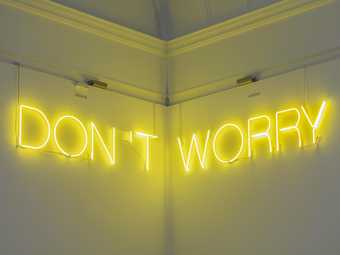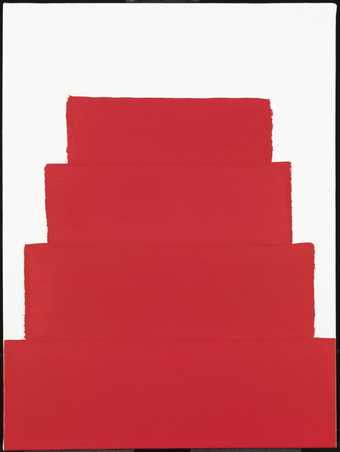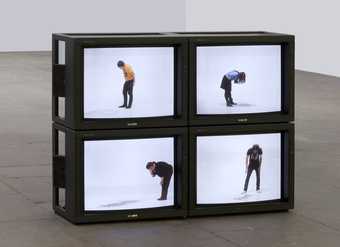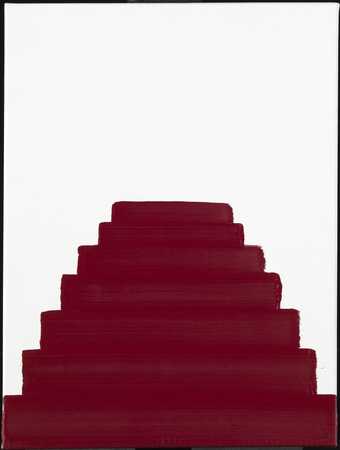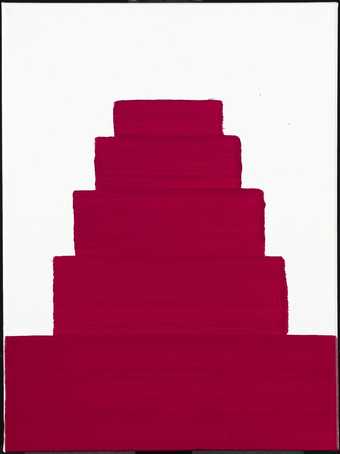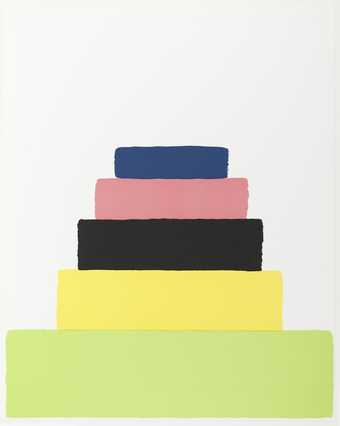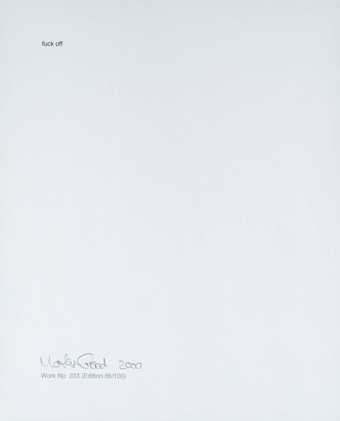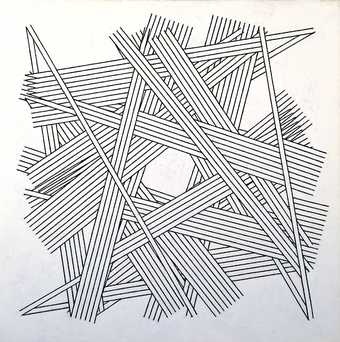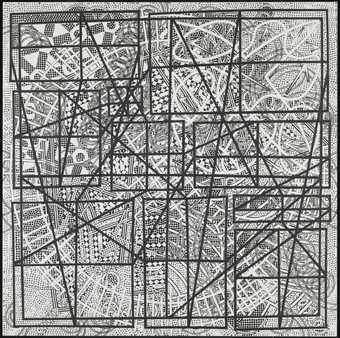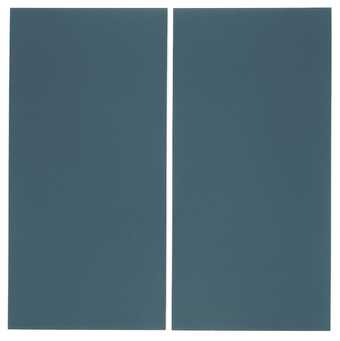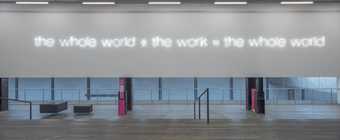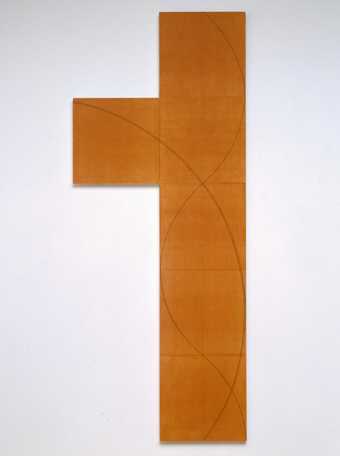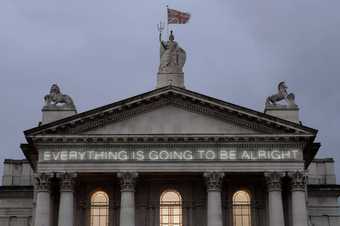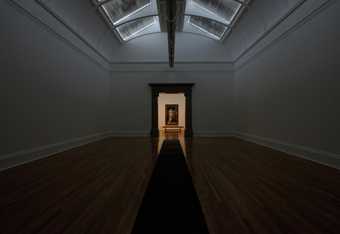
- Artist
- Martin Creed born 1968
- Medium
- Acrylic paint on canvas
- Dimensions
- 610 × 457 × 22 mm
- Collection
- ARTIST ROOMS Tate and National Galleries of Scotland
- Acquisition
- ARTIST ROOMS Presented by the artist jointly to National Galleries of Scotland and Tate and acquired with assistance of the ARTIST ROOMS Fund, supported by the Henry Moore Foundation and Tate Members 2011
- Reference
- AR01153
Summary
Work No.1104 2011 consists of six thick horizontal rectangular strokes of deep opaque pink acrylic paint applied across a commercially prepared and unframed canvas. The bands of paint appear as though they are stacked on top of each other, and narrow incrementally in width from bottom to top so as to form a ziggurat shape. The bottom stroke spans the entire width of the canvas. All of the white ground has been left exposed around the painted shape. The colour has been applied from left to right in a single layer of uniform thickness, with a set of flat brushes reducing in breadth from bottom to top (13 cm, 10 cm, 8 cm, 6.5 cm, 5 cm and 4 cm). The artist’s signature and the date (‘Martin Creed 2011’) is written in pencil on the reverse top edge of the canvas.
Work No.1104 is one of a series of paintings that the artist started making in 2006. Each work consists of one colour of acrylic paint applied according to the range of sizes available in one standard pack of household brushes. The first painting in this series, Work No.508 (Black Painting) 2006 is composed of a stack of horizontal rectangular bands similar to Work No.1103 except that the sequence of painted strokes reverses so that the thinnest band is at the bottom with the strokes getting thicker towards the top. Another work of 2006, Work No.585, consists of black strokes that are stacked along the left hand margin. Subsequent related paintings include Work No.596 2006, Work No.903, Work No.904, Work No.930, Work No.931, Work No.932, Work No.933, Work No.977 (all 2008), Work No.991 2009 and Work No.1315 2011.
Work No.1104 can also be compared to Creed’s stacked sculptural works including Work No.67 (As many 1” squares as are necessary cut from 1” masking tape and piled up, adhesive sides down, to form a 1” cubic stack) 1992, and to later sculptures such as Work No.396 2005 which consists of piled up planks of wood, and Work No.916 2008 and Work No.998 2009 which consist of stacked boxes and chairs respectively. Creed regularly returns to pre-existing motifs and processes when making new work. The artist has stated: ‘it has always been kind of like that for me, like going back to things and looking at [my works] again, jumping backwards and forwards.’ (‘Martin Creed: Twenty (More) Questions by Corinna Durland’, http://www.martincreed.com/site/words/questions-by-corinna-durland, accessed 11 January 2013.)
Links also exist with his first catalogued work, Work No.3 (Yellow Painting) 1986, described by Creed as ‘a single swirly brushmark made with a big brush on a small canvas. I was trying to simplify things: I wanted to make a painting with just one brushmark, one wave of the arm. I would like to make work that is direct and not thought-out, like a convulsion or a natural event. That painting was a bit like that.’ (Martin Creed Works, 2010, p.1015.)
Journalist Miranda Sawyer, commenting on the ziggurat paintings, has remarked: ‘These works are all about restrictions: impersonal rules which require a quick, definitive line in space in order to complete the task ... the mark made must be directly proportional to the ground one. And so on, until there aren’t any paintbrushes left in the packet. Part random, part ordered.’ (Miranda Sawyer, ‘People Know What’s Fake and What’s Not’, Observer, 18 July 2010, http://www.guardian.co.uk/artanddesign/2010/jul/18/martin-creed-interview-miranda-sawyer, accessed 11 January 2013.)
Work No.1104 emblematises a number of central themes and strategies found in much of Creed’s work, such as an economy of means and processes, minimal ordering and incrementation, and a certain playfulness. In this particular case the work demonstrates the artist’s reluctance to make overly conscious choices, specifically about what size of brush to select. He has stated that ‘I find it difficult to chose, or to judge, or to decide’ (cited in Virginia Button and Charles Esche, Intelligence. New British Art 2000, exhibition catalogue, Tate Britain, London 2000, p.49). Using all of the brushes equally is a way of avoiding having to choose one over another. For psychoanalyst Darian Leader, ‘These pieces are both testimony and solution to indecision’ (Martin Creed Works, 2010, p.xxxix). Regarding Creed’s paint choice, the critic Michael Archer has linked the artist’s approach to that of an acknowledged influence, the abstract painter Frank Stella (born 1936) who once said that in each of his canvases he was trying to ‘keep the paint as good as it was in the can’ (cited in Ikon Gallery 2008, p.36). Creed’s work is generally linked to a wide range of art movements from conceptualism, minimalism, situationism, abstraction and the ‘young British artist’ movement of the 1990s. However, Creed often resists categorizing his work according to such a lineage, remarking with an air of naivety, humour that ‘everything is kind of a little experiment in trying to make enough decisions to be able to come up with something I am happy with’ (Martin Creed Works, 2010, p.x).
Work No.1104 and the three related works also gifted to ARTIST ROOMS (Work No.1102 2011, Tate AR01150; Work No.1103 2011, Tate AR01152; and Work No.1105 2011, Tate AR01154) were donated to the ARTIST ROOMS collection before being publicly exhibited. Collectively they form something of a sequential unit in having four, five, six and seven colour bands respectively. Creed became the first new artist to join the ARTIST ROOMS collection after its formal establishment in 2008 when he donated a complete ‘room’ of his work in 2012, including this work.
Further reading
Martin Creed: Works, exhibition catalogue, Southampton City Art Gallery 2000.
Martin Creed, exhibition catalogue, Ikon Gallery, Birmingham 2008.
Martin Creed, Tom Eccles, Massimiliano Gioni and others, Martin Creed Works, London 2010.
Andrew Patrizio
The University of Edinburgh
March 2013
The University of Edinburgh is a research partner of ARTIST ROOMS.
Does this text contain inaccurate information or language that you feel we should improve or change? We would like to hear from you.
Explore
- abstraction(8,615)
-
- non-representational(6,161)
-
- colour(2,481)
- geometric(3,072)
- monochromatic(722)
- formal qualities(12,454)
You might like
-
Martin Creed Work No. 944
2008 -
Martin Creed Work No. 890: DON’T WORRY
2008 -
Martin Creed Work No. 1102
2011 -
Martin Creed Work No. 837
2007 -
Martin Creed Work No. 1103
2011 -
Martin Creed Work No. 1105
2011 -
Martin Creed Work No. 1273
2011 -
Martin Creed Work No. 233
2000 -
Kenneth Martin Chance, Order, Change 6 (Black)
1978–9 -
Bernard Cohen Out There
1994–5 -
Alan Charlton 2 Part Vertical Painting
1991 -
Martin Creed Work No. 232: the whole world the work = the whole world
2000 -
Robert Mangold Column Structure II
2006 -
Martin Creed Work No. 203: EVERYTHING IS GOING TO BE ALRIGHT
1999 -
Martin Creed Work No. 227: The lights going on and off
2000


